Using online tools for car insurance quotes can feel like revealing a treasure trove of savings, yet many still rely on traditional methods. Why miss out on the efficiency and convenience that comes with instant access to competitive rates? These platforms not only streamline the process but also allow you to customize your coverage effortlessly. Let's explore how this modern approach can empower you to make informed choices without the usual pressure.
As you navigate the world of car insurance, online tools can simplify the process of obtaining quotes, making it both efficient and user-friendly. You can access these tools 24/7, allowing you to request quotes during lunch breaks or late at night when it suits you best. The elimination of paperwork streamlines the entire experience, guiding you through the necessary information step-by-step while minimizing human error. This self-service approach not only enhances convenience but also guarantees you're in control without the pressure of dealing with live agents.
The efficiency of using online tools is one of their biggest advantages. You can receive multiple quotes in mere minutes, which is a notable time saver compared to traditional methods. Forget about long wait times on the phone or making unnecessary trips to insurance offices. With just a few clicks, you can quickly compare quotes from various providers, allowing for instant decision-making based on the data available to you. This agile process empowers you to make informed choices promptly, especially considering that combining online tools with agent assistance maximizes the benefits of both approaches.
Cost and financial benefits also play a vital role in why you should consider online tools for car insurance quotes. Many platforms enable you to discover potential discounts that different insurers offer, making sure you don't miss out on savings. By identifying the most competitive rates, you can greatly lower your premiums. The ability to easily compare prices from various insurers helps you secure the best deal. Users have reported considerable savings simply by taking the time to compare quotes online, proving that this method can be financially advantageous.
When it comes to coverage options, the flexibility offered by online tools can't be overstated. You're not limited to basic policies; instead, you can explore a range of coverage options, from extensive to collision. Additionally, many platforms provide access to extra services like roadside assistance, which can enhance your policy's value. You can also tailor your coverage according to your specific needs, making sure that you get exactly what you require without paying for unnecessary extras.
Safety and security are top priorities for online platforms. Reputable marketplaces guarantee that your data is processed securely and transactions are handled safely. Many promise no spam or unsolicited calls, allowing you to explore options without the hassle of constant follow-ups. Trustworthy customer reviews can guide you in evaluating the reliability of different insurers, reducing the risk of falling victim to scams.
Finally, user experience is enhanced through expert assistance available on many platforms. Licensed agents can provide personalized advice for more complex situations, while user reviews and comparison tools simplify the decision-making process. Clear explanations of insurance jargon make it easier for you to understand your options, making certain that you're making informed choices.
Conclusion
In today's fast-paced world, using online tools for car insurance quotes is like having a personal concierge at your fingertips. You get the convenience of comparing rates and customizing coverage without the hassle of traditional methods. This empowers you to make informed choices tailored to your needs, all from the comfort of your home. So why wait? Immerse yourself in the digital age of insurance and discover how easy it is to secure the best deal for your vehicle.

